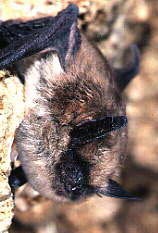Bats in South Carolina

Of all the mammals on Earth, bats are the only ones capable of true flight. They use elongated bones (similar to human fingers) and a thin wing membrane stretched between them. Most (about 70%) eat insects but there are some that consume fruits and nectar or small mammals, birds, lizards, frogs, and fish.
South Carolina’s bat species prey on insects and are of great economic importance to the state - they suppress nocturnal insect populations, including crop and forest pests, and reduce the need for costly pesticides. Bats save South Carolina’s agricultural industry over $115 million each year in pest suppression services, totaling $22.9 billion for the US annually. Bats also indirectly suppress pest-associated fungus and the toxic compounds they produce in corn, and help reduce the impact of pesticides on many other wildlife species that call South Carolina home. Sadly, many bat species have been declining rapidly due to White-nose Syndrome.
Join us for a Halloween Bat Count during #SCBatWeek
Annually on the last Friday of October
The 2024 event will be on Friday October 25. PAWS Animal Wildlife Sanctuary with educational owls will be there around 5:30 pm, and a bat talk will start around 6 pm. Sunset is 6:40 pm when the bats usually start to emerge, ending by 7:30 pm. Dress warm!
See South Carolina Bat Working Group webpage, FB page, and/or #SCBatWeek or for updates.
Sunrift Adventures
1 Center Street, Travelers Rest, SC
Sunrift Adventures has bat houses fostering hundreds of beneficial, insect-eating bats that' emerge in an impressive display at sunset. Join us while we survey and celebrate these mysterious creatures with a bat talk, bat count, prizes and more!
Of the 47 bat species documented in the United States (US), 15 are found in South Carolina:
- Big brown bat (Eptesicus fuscus)
- Brazilian free-tailed bat (Tadarida brasiliensis)
- Eastern red bat (Lasiurus borealis)
- Eastern small-footed bat (Myotis leibii)
- Evening bat (Nycticeius humeralis)
- Gray bat (Myotis grisescens)
- Hoary bat (Lasiurus cinereus)
- Little brown bat (Myotis lucifugus)
- Northern long-eared bat (Myotis septentrionalis)
- Northern yellow bat (Lasiurus intermedius)
- Rafinesque's big-eared bat (Corynorhinus rafinesquii)
- Silver-haired bat (Lasionycteris noctivagans)
- Southeastern bat (Myotis austroriparius)
- Seminole bat (Lasiurus seminolus)
- Tricolored bat (Perimyotis subflavus)
Past incidental records exist of the big free-tailed bat and the federally endangered Indiana bat, but are considered very rare in the state. For detailed information on each of these species, see Chapter 3: Species Accounts of the SC Bat Conservation Plan.
 Related Links
Related Links
- Amazing and Beneficial Bats, Zoom talk by SCDNR Jennifer Kindel for SC Wildlife Federation
- No humane way to exclude bats from May – July: human and bat pup safety info
- Guide to Gardening for Bats
- Bats in Buildings
- Rabies in Bats
- Bats of South Carolina
- Creatures of the Night bat video
- The Truth About Bats - Amy Wray, TED-Ed cartoon video
- Bat House Resources: BCI or Merlin Tuttle
- Bat Box Builders Handbook pdf
- Direct Links to Research Tested Bat Houses: Rocket or 4-chamber
- Bats of the Southern Appalachians
- Big Brown Bat
- Bats and Diseases
- Bat Conservation International
- Merlin Tuttle's Bat Conservation
- North American Bat Monitoring Program (NABat)
Bat Research
The grants listed in the tables below are those that have been completed and closed as of 2017 as well as grants currently in progress. You can access each final report by clicking on its link.
(Documents below are in PDF format.)
